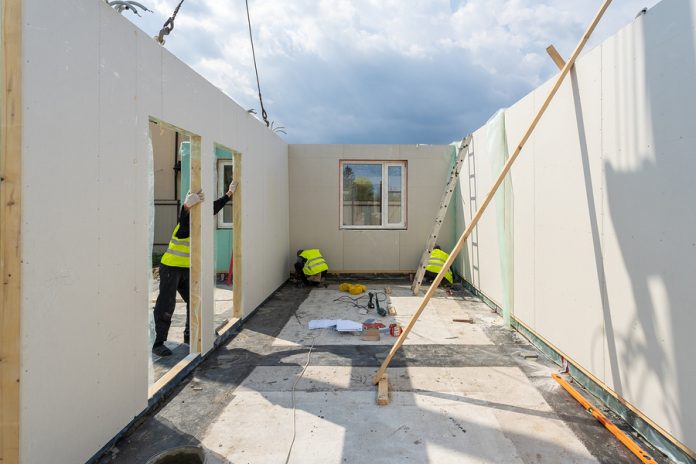The housing market as we know it is shifting; the UK is facing an ongoing housing crisis, exasperated by rising housing prices and an ever-growing population which is forcing traditional housing methods to evolve
Everyone from homeowners to construction experts are rushing to look for an alternative to conventional homes. And modular buildings could be just the answer.
Not only in the UK, but globally, housing markets are under more strain than ever before. Political instability and turbulent economies have led to stagnating construction. Skills shortages and rising materials costs, both of which have been exacerbated by political events such as Brexit, have hindered traditional housebuilding which has, in turn, caused house prices to rise disproportionately to salaries.
As a result, more and more first-time buyers are finding themselves unable to get on the property ladder. Yet meanwhile, populations are rising meaning more affordable housing is needed urgently.
Chair of Homes England, Edward Lister has said that “it’s no secret that the housing industry has been facing significant productivity and skills challenges in recent years”. So, with existing construction no longer proving effective, we need housing solutions fit for the future.
As a result, interest in the modular building sector has grown significantly. Homes England are just one of many UK companies who have declared themselves committed to championing modern methods of construction, such as modular buildings, to increase the pace of home delivery across the country. And the use of them is only set to grow, as governments around the world seek solutions to stimulate floundering homebuilding rates and support first-time buyers struggling to access the property ladder.
What are modular buildings?
Whilst modular buildings may sound daunting and futuristic, they needn’t be. To put it simply, modular units are buildings which are constructed in factories, rather than onsite. After being built in sections in a factory environment they are then delivered to their intended site and put together from these prefabricated modules. They are incredibly versatile and can be designed in a variety of formats to suit the end user’s needs.
In the case of modular homes, these buildings can be designed to be near-identical to traditionally constructed houses, complete with all the accessories and appliances associated with a traditional home.
Where are modular techniques being used?
The increasing use of modular buildings as homes in the future is more than just a possibility. Modular buildings have in fact already begun to be introduced as a housing solution in a number of locations.
One example of a place which has adopted modular homes is Bridgend in Wales, where a recent housing development has been established entirely with the use of modular construction techniques.
Constructed using techniques which significantly increase the speed of housing delivery, the Welsh Government supported this scheme and, after witnessing its success, awarded funding to develop additional new modular home schemes in Sarn and Tondu.
It took as little as three weeks to produce the homes in Wales, which arrived on site complete with appliances, heating and electrics pre-fitted. Once complete, brick cladding and trussed roofs were added, rendering the new homes indistinguishable from their traditionally constructed counterparts.
Places for People, one of the UK’s largest housing associations has also recently agreed to buy 750 modular homes as part of a £100m deal. This is the largest investment by a UK housing association into modular homes and signifies a future in which modular homes play an increasing role.
Other nations are also following suit. In British Columbia, Canada, for example, two new modular housing projects were announced last year. One of these projects, Abbotsford, is part of one of the largest “housing first” programs seen to date. In “housing first” programs, homeless people are provided homes without having to meet traditional requirements. This demonstrated how modular constructions can be a useful tool in supporting social issues.
Why do modular buildings make good homes?
One of the reasons that modular buildings are being championed as an alternative to traditional homes is their versatility. No matter the needs and preferences of the eventual homeowner, modular buildings can be designed to meet these.
Not to mention that modular constructions are affordable, quick to construct and environmentally friendly. Compared to traditional construction methods, modular homes are delivered up to 50% faster, reducing environmental impacts and disruption to local residents as well as cutting costs by around 35%.
The fact that they can be delivered in around half the time of a traditional building makes them hugely important in the midst of the current housing shortage. They can also be delivered on problematic brownfield sites, which typically ramp up the development cost, do not accommodate affordable housing and often put off private developers.
Another factor increasing the affordability of these buildings is the fact that they are often manufactured close to their end location, saving costs further by preventing the need for transportation which can rake up sizable logistics bills. This also awards modular constructions with greater social value as they support local economies by providing employment to nearby residents. As environmental awareness grows, this cut in the carbon footprint- around 67% less energy is required- is another appealing benefit.
What does the future look like for modular homes?
Adequate housing is one of the biggest challenges facing councils across the UK and governments across the globe, and modular homes appear to provide a solution. According to a Knight Frank survey of housebuilders and developers published last year, the vast majority of housebuilders and developers anticipate that modular buildings will have a considerable impact on the construction sector in the next five years.
Not only do modular constructions provide a solution to housing pressures, but societal expectations of housing are evolving and this kind of structure also provides the flexibility to meet these. Movements such as cohousing are on the rise, inspired by the popularity of such schemes in Scandinavia. As part of cohousing, groups of people looking for an alternative to traditional living opt to buy land together before self-building modular homes on this.
In the coming years, this movement and others like it are set to push the expectation of what our homes should look like, and with it allow the modular building sector to flourish.
HTS














